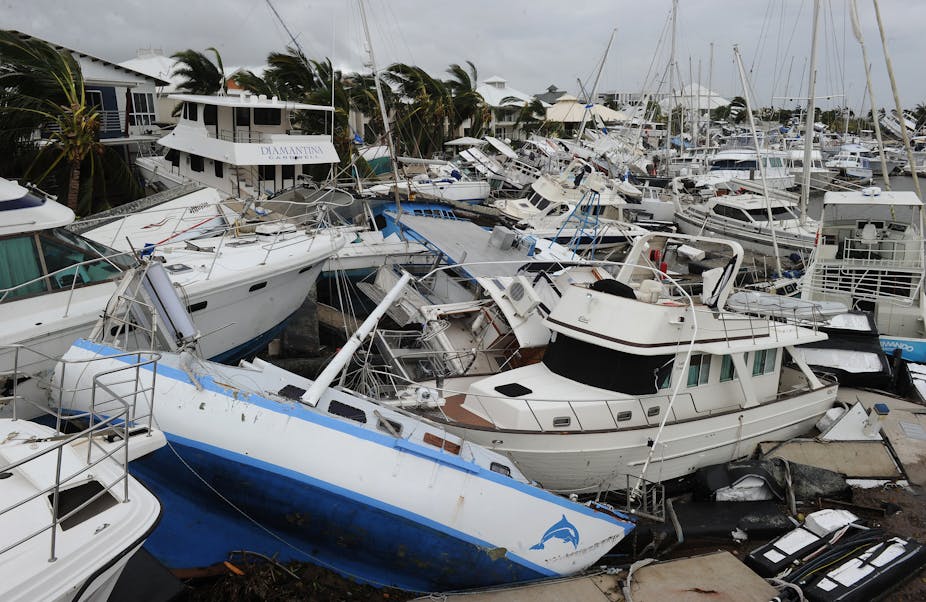The number of tropical cyclones hitting Queensland and Western Australia has fallen to low levels not seen for more than 500 years, new research published in Nature shows.
But while that’s seemingly great news for people in cyclone-prone areas, our new research into Australia’s past cyclone records also highlights a serious risk.
Low-lying coastal areas such as Cairns, Townsville and Mackay in north Queensland have all been developed on the unproven assumption that the cyclone activity of the past 40 years will continue unchanged into the future.
The concern is that our new results closely matched several recent studies that have projected fewer – but increasingly intense – tropical cyclones for Australian region due to global climate change.
And if those projections prove to be right, we are taking a big gamble with existing homes, roads and offices, as well as threatening proposed developments such as the A$4.2 billion resort casino planned for low-lying coastal land near Cairns.

There is no such thing as a risk-free development, especially when building in cyclone-prone regions. However, being properly informed and cautious about developments in such regions is in all Australians’ interests - because if we get it wrong, we all stand to pay through higher insurance premiums and largely taxpayer-funded disaster clean-ups.
Limestone cave time machines
Our study shows that current seasonal cyclone activity is at its lowest level in Western Australia since 500 AD and since about 1400 AD in Queensland. That decline began about 40 years ago.
While Australia’s official cyclone records only date back to 1906, we can track cyclones further back in time using measurements of isotopes housed within limestone cave stalagmites. Those stalagmites grow upwards from the cave floor as rainwater containing dissolved limestone drips from the cave ceiling.
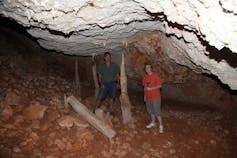
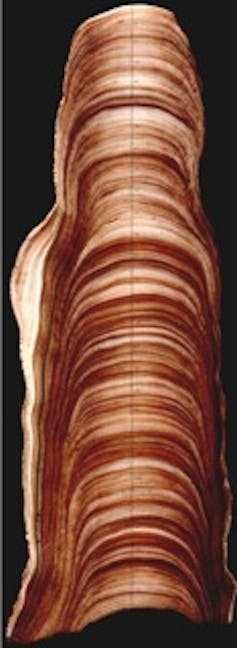
The isotope chemistry of tropical cyclone rainwater differs from that of monsoonal and thunderstorm rainwater. As a consequence, it is possible to analyse the chemistry of each of the stalagmite layers, which are approximately 1/10th of a millimetre thick, and generate a record of cyclones over the past 1500 to 2000 years.
My colleague Jordahna Haig then matched the isotope records with the Bureau of Meteorology’s cyclone record over the past 40 years and generated a Cyclone Activity Index, which plots the seasonal activity of cyclones over the past 1500 years.
In the short term, the recent decline in tropical cyclone activity is good news for all those who live in and visit tropical north Queensland and Western Australia. However, there are some possible dark clouds on the horizon that we would be reckless to ignore.
Global trends
Several recent studies published in leading journals - including these papers involving the Australian Bureau of Meteorology, Columbia University, and the Massachusetts Institute of Technology - have all separately projected the frequency of tropical cyclones will decrease in the Australian region due to global climate change.
But while the number of cyclones is expected to decrease, the intensity of those cyclones that do occur is expected to increase.
Those previous studies have suggested we would see those changes occur towards the middle to the end of the 21st century. However, our new study suggests this decline in cyclone frequency is already occurring.
We cannot be sure that this current decrease in cyclone activity is due to climate change - but it is mirroring the forecasts.
Our results also confirm the conclusions of other studies into long-term cyclone behaviour, which show that the past 40 to 100 years of cyclone activity in Australia has been very low compared to times previous.
Planning based on a lull in the storm
The results of our study suggest that we may have a problem with coastal development in cyclone-prone regions, particularly in built-up parts of Queensland.
For many years, Western Australia had a more cautious approach on where coastal development was allowed, not allowing development any closer to the coast than where marine inundation occurs in a category 5 cyclone. However, this policy has now changed and is now more in line with Queensland coastal policy.
In northern Queensland, state and local government policies on minimum habitable floor levels for building within storm surge zones are only based on the history of cyclones over the last 40 years, and 100 years at best.
This period is unrepresentative of the natural variability of cyclones. So relying on this narrow window of time means that we are making risky assumptions about where it is safe to build homes, tourist resorts and vital public facilities such as hospitals.
The question can be asked as to why government policies do not base their minimum habitable floor levels on the studies of longer-term cyclone activity and a more comprehensive view of cyclone variability.
The reason probably lies in the different approaches used to derive these records.
The studies underpinning current planning policies are usually undertaken by practitioners who use only 40 years of actual cyclone records to generate long synthetic records, stretching out over thousands of years, up to 1.5 million years. The underlying assumption is that a short 40-year window of time is a true reflection of longer-term cyclone behaviour.
An alternative way to come up with a more conservative, long-term view of where cyclones could strike is by using geological or geochemical records, which register actual cyclone events.
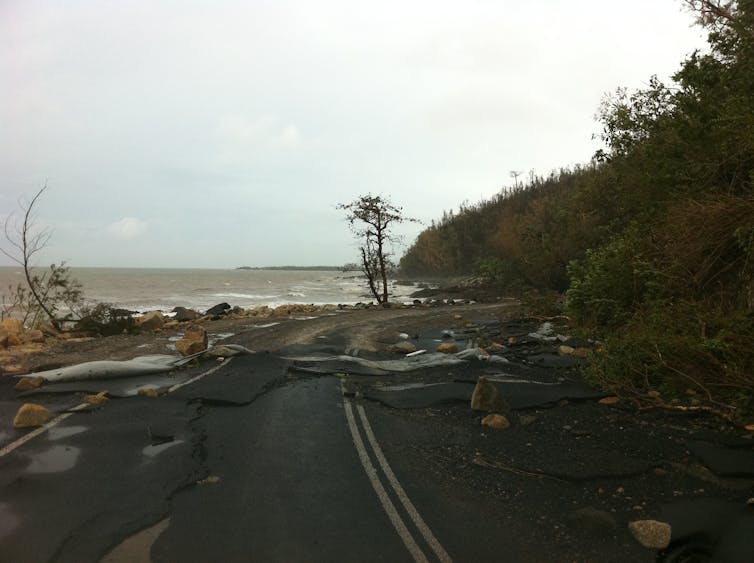
Risky decisions
Our new research findings raise significant questions about how we plan for and develop cyclone-prone areas.
Consider these three scenarios.
The first - and luckiest - scenario would be for Australia to continue to have a low frequency of cyclones as we have in the past 40 years, with no increase in intensity when cyclones do hit. That’s the best possible scenario.
A second scenario - based on what we can see from our geological records - would be for this current calmer period to be simply a lull in the storm. If that’s the case, then we should be planning for a return to a higher, more historically “normal” number of tropical cyclones - meaning taking a more cautious, conservative approach in the way we develop tropical areas.
A third scenario - based on what we can see from our geological records, plus future projections that are in line with what we’ve seen in the past - would be that Australia may continue to see fewer tropical cyclones. However, when those cyclones do occur, they are more likely to be more intense, meaning greater risks to people and property. Again, this scenario would call for a more cautious, conservative approach in the way we develop tropical areas.
If either scenario two or three occurs, then many northern Australian coastal developments could be impacted by storm surge and inundations in the relatively near future.
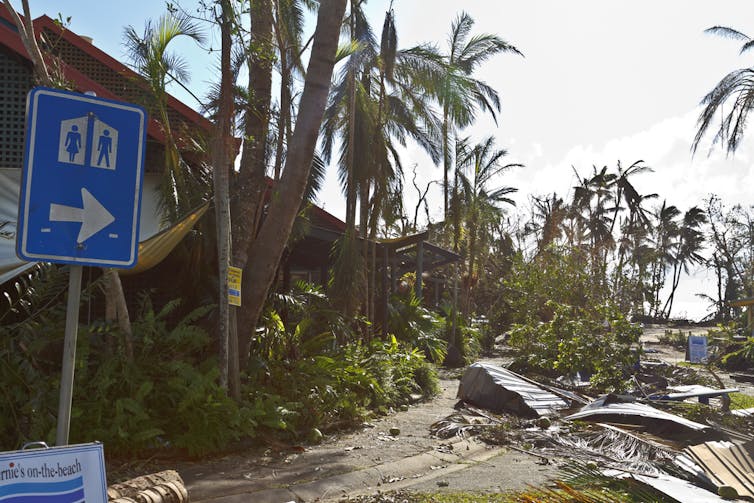
Hope for the best, prepare for the worst
Essentially, we are faced with a choice. Continue to hope and plan for the best, as if this current 40-year lull will continue. Or hope for the best, but prepare for the worst.
It is also worth debating some of the ways in which state governments are ramping up coastal development, such as the Queensland government’s recent decision to remove a safeguard in state planning policy to consider future sea level rise (which could worsen storm surges in a cyclone).
The conservative approach that I believe is worth taking, based on our research and that of others, appears to be the opposite of what is now happening. So here’s hoping that Australia will continue to enjoy a relative lull in how often we have to face tropical cyclones.

